Nailing Your Health Problems

What do dentists, blackjack dealers, and teachers all have in common? They have their nails on display at all times. Your nails reveal more than you might think. When you have a nail disorder, people notice.
That might be a good thing. Being aware of the health of your nails could give you an early warning of a serious problem that needs your attention. It can even save your life in some cases. Learn what your nails and nail discoloration may suggest about your health.
When Nails Grow Pale
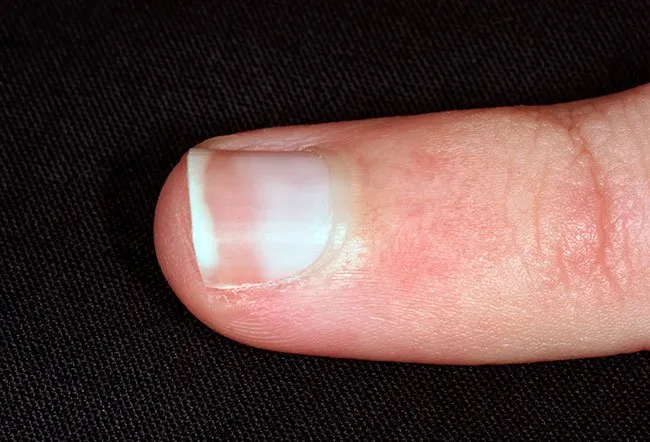
While they can have many other causes, pale finger and toenails are a common sign of aging. In one survey of patients over age 60, almost 3 in 4 had developed pale, dull nails. However, pale nails can indicate more serious health problems in some individuals. The next slide will discuss some of those. Rather than wonder what caused them, ask your doctor for an examination if you’ve noticed your nails have become pale.
White Nails

There are many reasons why only one nail may be partly or entirely white, including injury, and some of these reasons will be discussed later. In any case, when all your nails change to the same unusual white pattern, this suggests you should go to your doctor for further testing. White nails with a pink band at the top of the nail bed are called Terry's nails, and they may signify a serious health condition. The white half-moon area at the base of your nail is called the lunula, Latin for "little moon." With Terry's nails, the lunula is indistinguishable from the rest of the nail. When this appears, it suggests your body's veins have changed beneath your nail.
This symptom may indicate the following serious diseases:
- Cirrhosis of the liver
- Chronic kidney failure
- Congestive heart failure
Although Terry's nails may suggest a serious condition, it can also appear in seniors as a normal part of aging. And some people have all-white fingernails or white toenails like this throughout their lives, which suggests a harmless genetic trait. To rule out more serious causes, ask your doctor for an examination.
Yellow Nails
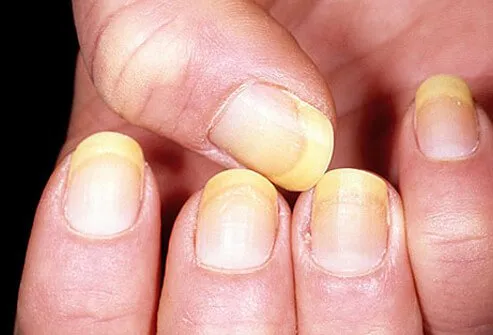
Nails can yellow for a wide variety of reasons. The most common cause is fungal infection. Smokers may yellow their nails with tobacco. If they resist treatment, your yellow nails may indicate psoriasis, thyroid problems, or diabetes.
In rare cases, so-called "yellow nail syndrome" (YNS) occurs in patients with serious lung disease and swelling of the extremities (lymphedema). This almost always develops in patients over age 50, though children with the syndrome have been reported. In these patients, most if not all of the nails are yellowish. Sometimes YNS goes away on its own. But if it doesn't, vitamin E may help, as well as medication.
Blue Nails

What makes fingernails blue? Nails can take on a blue appearance for lots of reasons. Technically your nail isn't blue—just the nail bed beneath. Your nail bed is free of skin pigment, leaving it vulnerable to blue coloring in several ways.
Silver Poisoning
One cause of blue nails is silver poisoning (argyria). Because your nailbeds have no skin pigment, they can be one of the first places to show signs of silver deposits. This irreversible condition can become worse with increased exposure to silver, and may eventually appear across sun-exposed skin areas. People who work with silver, including silver miners and silverware manufacturers, are at risk of argyria. So too are people who take silver (possibly as silver salts) as an alternative medicine.
Medications
Some medications may leave your nail beds blue. These include drugs used to fight malaria (antimalarials), drugs used to fight psychosis (phenothiazines), and a drug used to regulate heartbeat (amiodarone). At least one case of blue fingernails seemed to result from the rosacea fighting medication minocycline.
Occupational Hazards
Some jobs can leave fingernails blue. Mechanics sometimes get them because of the oxalic acid sometimes used to clean radiators. People who use metal cleaners, paint removers, or who manufacture inks or dyes may also develop blue nails.
HIV Infection
People infected with HIV may develop blue nails in two ways. First, the infection itself seems to cause this distinct sign. Second, some antiretroviral medicine has also been associated with blue nails.
Cyanosis
Cyanosis is a low or lack of oxygen in your red blood cells that may result in the skin underneath your nails and elsewhere like the feet, lips and/or mucous membranes to be a bluish-purple color. Cold temperature exposure or abnormally high hemoglobin levels may cause cyanosis. Cyanosis also may result from an underlying chronic disease like COPD or asthma or occur acutely from an inability of the body to deliver oxygenated red blood cells (pneumonia or pulmonary embolism, for example). Acute cyanosis can be a sign of a medical emergency.
Rippled Nails
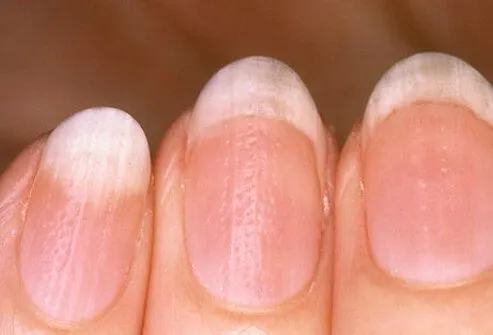
What are pitted fingernails? Nail pitting is a classical sign of psoriasis in the nail. This appears as tiny holes in the nail surface. Rippling of the nail surface is seen in patients with dermatitis of the fingertips. This can be a result of atopic dermatitis, irritant dermatitis, or allergic contact dermatitis.
Split or Cracked Nails
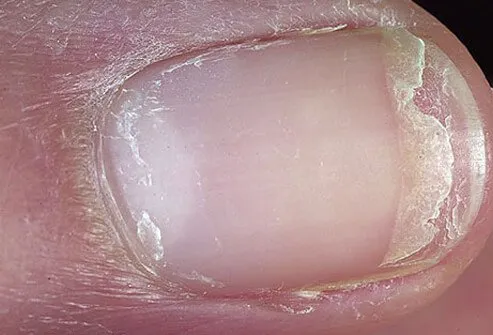
Nail brittleness is a common condition of the elderly. Typically, brittle nail causes remain undiscovered, partly because there are so many potential causes. Nail brittleness can result from drugs, a trauma to the nail, or a number of diseases or nutrient deficiencies. When brittle nails split, the name your dermatologist uses may depend on how they split. When nails begin to split horizontally, the condition is called onychoschizia. But when they split along the direction the nail grows, this is called onychorrhexis.
Preventing Brittle Nails
It may be difficult to treat your nails by the time they begin splitting and cracking. So, prevention may be your best bet. There are many potential ways to treat this condition. Potentially useful prevention methods include supplements. These may take the form of vitamin supplements (particularly biotin), amino acids, or certain minerals such as zinc.
Puffy Nail Fold Infection

Chronic paronychia is a condition that causes inflammation, redness, tenderness, and swelling of the skin folds and tissues surrounding the nails. It is usually the result of irritants or allergens but it can be caused by the fungus Candida albicans, other infections or psoriasis. It can usually be treated with topical steroids.
Dark Lines Beneath the Nail
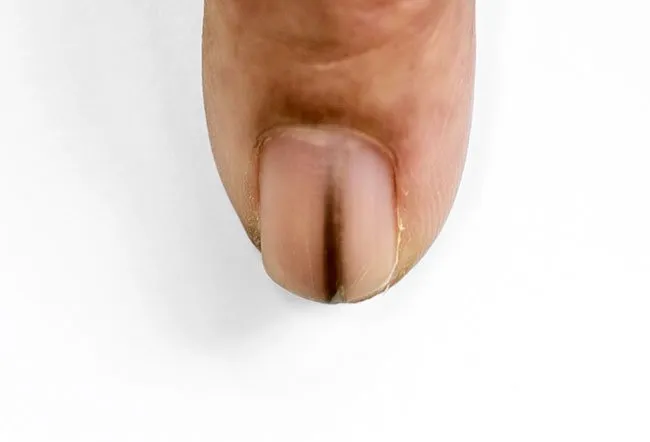
This nail discoloration is called a melanonychia and is caused by the pigment melanin. There are several possible causes including skin cancer, infection or injury.
Gnawed Nails
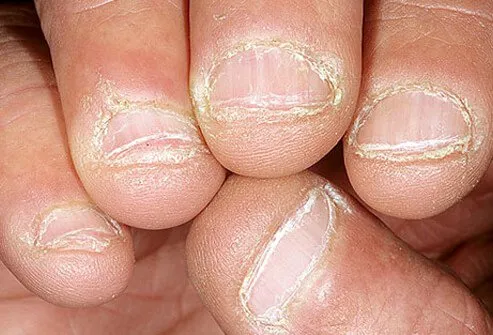
Biting your nails may be nothing more than an old habit, but in some cases it's a sign of persistent anxiety that could benefit from treatment. Nail biting or picking has also been linked to obsessive-compulsive disorder. If you can't stop, it's worth discussing with your doctor.
Nails Are Only Part of the Puzzle

Changes in the nails occasionally may signal a significant systemic disease. Most of the time, nail signs are self-limited and tend to resolve on their own. Patience is a necessity in dealing with nails because their turnover is slow. It may take many months for a damaged nail to replace itself entirely.
Nail Disorders: What Nails Say About Your Health
This tool does not provide medical advice. See additional information: 
© 1996-2024 WebMD, LLC. All rights reserved.
